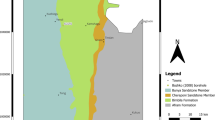Abstract
Water is the most precious resource available for mankind. Due to the rapid increase in population, urbanisation and agricultural expansion place additional demand for water. Groundwater is an alternative source of fresh water available to support a human. However, Papua New Guinea’s (PNG) difficult geography and excessive hard rock formation make it challenging for authorities to carry out groundwater development programs. To combat this complexity, an integrated approach based on remote sensing (RS) and geographic information system (GIS) application through multi-criteria evaluation (MCE) technique was adopted for exploration and delineation of groundwater potential zones. A range of influential factors including geomorphology, lithology, soil, rainfall, drainage, slope, elevation, land use/land cover and inundation were analysed and integrated in ArcGIS10 through weighted overlay index techniques. A detail data evaluation criteria were developed with suitability rankings and weightings applied to each parameter. Weightage were assigned based on probability influence, i.e., geomorphology—16%, soil—16%, lithology—15%, drainage—15%, rainfall—10%, topographic slope—9%, elevation—9%, land use/land cover—5% and inundation—5%. After weighted overlay operations, a groundwater prospective zonal map layer was generated and classified in terms of very poor, poor, moderate, good and very good. The area occupied are poor—2.38%, very poor—11.21%, moderate—60.75%, good—16.47% and very good—9.19% respectively.













Similar content being viewed by others
References
Basavaraj DB, Hiremath CG, Davaithuraj J, Purandara BK (2016) Identification of groundwater potential zones using ArcGIS10.1. International Journal of Advances in Mechanical and Civil Engineering Special Issue, Sep. 31–35
Bhunia GS, Samanta S, Pal B (2012) Deciphering prospective groundwater zones of Morobe province, Papua New Guinea. Int J Eng Res Appl 2(3):752–766
Biswas A, Adarsa J, Sharma SP (2012) Delineation of groundwater potential zones using satellite remote sensing and geographic information system techniques: a case study from Ganjam district, Orissa, India. Res J Recent Sci 1(9):59–66
Bonham-Carter GF (1994) Geographic information systems for geoscientists: modelling with GIS, Elseviers Science Ltd., ISBN: 9781483144948, pp. 398
Fashae OA, Tijani MN, Talabi AO, Adedeji OI (2014) Delineation of groundwater potential zones in the crystalline basement terrain of SW-Nigeria: an integrated GIS and remote sensing approach. Appl Water Sci 4:19–38
Jeyapprabha R, Revathy SS, Sureshbabu S (2014) Study on landuse pattern to evaluate groundwater potential zone for Bengaluru urban area using RS & GIS techniques. Int J Comput Sci Inform Technol 5(2):1213–1218
Kalantari N, Khoobyari A, Charchi A, Keshavarzi MR (2010) Deciphering groundwater potential zones in sand stone terrain based on GIS applications (case study: Masjed-e- Soleiman, Iran). The 1st International Applied Geological Congress, Department of Geology, Islamic Azad University - Mashad Branch, Iran, 26–28 April 2010
Lukoko P, Mundia C (2016) GIS based site suitability analysis for location of a sugar factory in trans Mara district. Int J Sci Basic Appl Res 225(3):328–339
Nag SK (2005) Application of lineament density and hydro-geomorphology to delineate groundwater potential zones of Baghmundi block in Purulia district, West Bengal. J Indian Soc Remote Sens 33(4):513–521
Nag SK, Lahiri A (2011) Integrated approach using remote sensing and GIS techniques for delineating groundwater potential zones in Dwarakeswar watershed, Bankura distict, West Bengal. Int J Geomatics Geosci 2(2):430–442
Ravi Shankar MN, Mohan G (2006) Assessment of the groundwater potential and quality in Bhatsa and Kalu river basins of Thane district, western Deccan Volcanic Province of India. Environ Geol 49:990–998
Saaty TL (1980) Analytic hierarchy process: planning, priority setting, resource calculation. McGraw-Hill International Book company, New York, ISBN: 978-0070543713, pp 1–287
Samanta S, Koloa C, Pal DK, Palsamanta B (2016) Flood risk analysis in lower part of Markham river based on multi-criteria decision approach (MCDA). Hydrology 3(29):1–13. https://doi.org/10.3390/hydrology3030029
Shiba M (1995) Analytic hierarchy process (AHP) based multi attribute benefit structure analysis of road network forest road investments to minimize environmental effects. Int J For Eng 17:51–70
Sikdar PK, Chakraborty S, Adhya E, Paul PK (2004) Land use/land cover changes and groundwater potential zoning in and around Raniganj coal mining area, Bardhaman District, West Bengal: a GIS and remote sensing approach. J Spat Hydrol 4:1–24
Soraganvi NVS, Hooli SS (2015) Groundwater potential mapping in a part of Malaprabha river basin using remote sensing data and geographic information system (GIS). J Environ Earth Sci 5(5):36–40
Todd DK (1980) Groundwater hydrology (2nd edn.). Wiley, New York, ISBN: 9788126508365, pp 1–535
Valliammai A, Balathanduythm A, Tamilmani D, Mayilswami C (2013) Identification of potential recharge zone of the selected watershed using remote sensing and GIS. Int J Sci Eng Res 4(8):611–616
Vecchioli J, Bennett GD, Pearson FJ Jr, Cerrillo LA (1974) Geohydrology of artificial recharge site at Bay Park, Long Island, New York. U.S. Geological Survey, Professional paper 751-C
Waikar ML, Nilawar AP (2014) Identification of groundwater potential zone using remote sensing and GIS technique. Int J Innov Res Sci Eng Technol 3(5):12163–12174
Weston LK, Swain RE (1979) Artificial recharge in South Platte River basin. J Irrig Drain Eng 105(2):117–127
Author information
Authors and Affiliations
Corresponding author
Ethics declarations
Conflict of interest
The authors declare that they have no conflict of interest.
Rights and permissions
About this article
Cite this article
Poi, N., Samanta, S. GIS, remote sensing and MCE approach for identifying groundwater prospective zones in mountainous region of PNG. Appl Geomat 11, 317–330 (2019). https://doi.org/10.1007/s12518-019-00259-6
Received:
Accepted:
Published:
Issue Date:
DOI: https://doi.org/10.1007/s12518-019-00259-6




